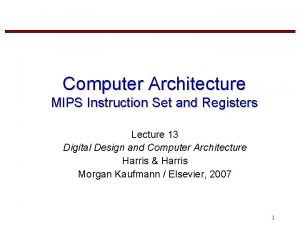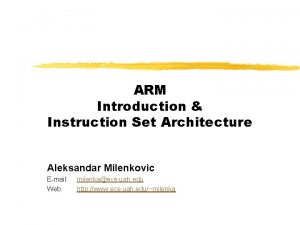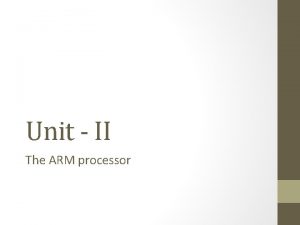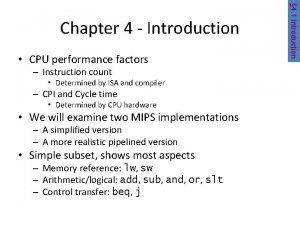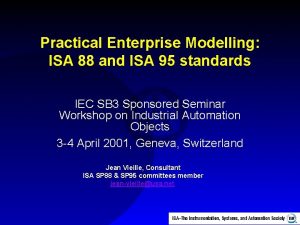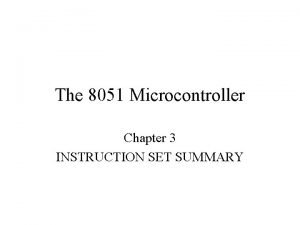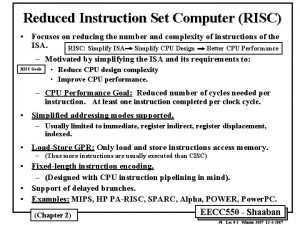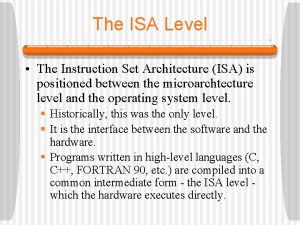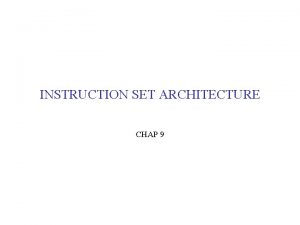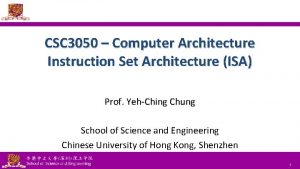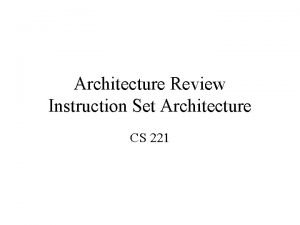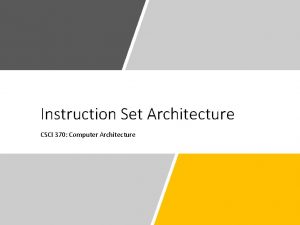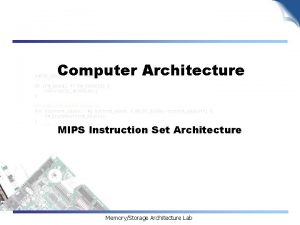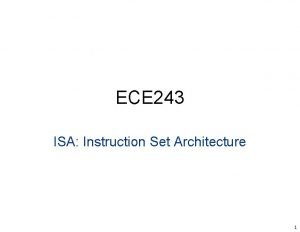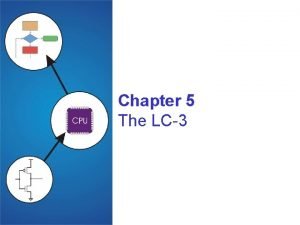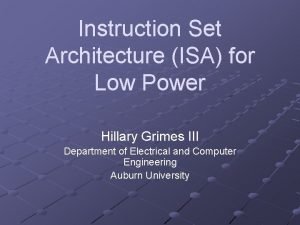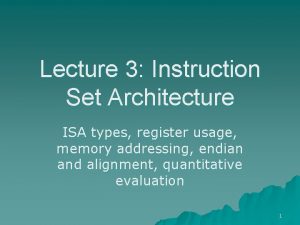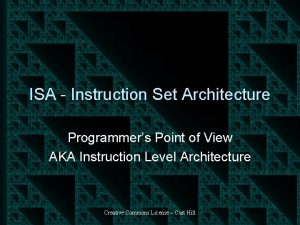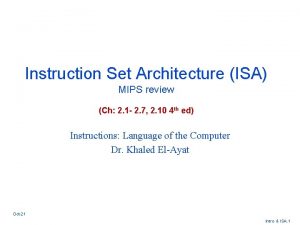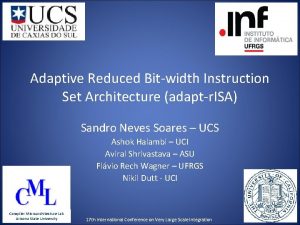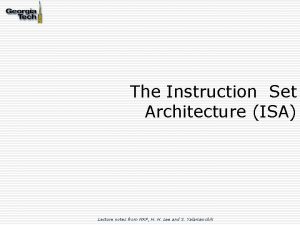Recap 1 Instruction Set Architecture ISA The ISA





















- Slides: 21

Recap 1

Instruction Set Architecture (ISA) • The ISA is the interface between hardware and software. Software Proc #1 ISA Proc #2 • The ISA serves as an abstraction layer between the HW and SW – Software doesn’t need to know how the processor is implemented – Any processor that implements the ISA appears equivalent 2

What is instruction set architecture (ISA)? • Instruction set of a computer: the portion of the computer visible to the assembly level programmer or to the compiler writer ISA – Defines registers – Defines data transfer modes (instructions) between registers, memory and I/O – There should be sufficient instructions to efficiently translate any program • Next, define instruction set format – binary representation used by the hardware – Variable-length vs. fixed-length instructions 3

Growth/Variations of Processors 4

Instruction Set Architectures • There are 4 classes of ISA – Stack • Embedded processors – Accumulator • Embedded processors – Register-memory • Pentium – Register-Register (Load-store) • Sparc 5

Instruction Set Architecture • For a general purpose high-performance computer – Register-Register (Load-store) is the preferred choice • CPI uniform for most instructions – Better pipelining • Fixed length instructions – Simpler encoding • The complier is more complicated 6

Important issues to consider for designing an ISA • What are the different addressing modes that should be used • What is the length of instructions • What are the different instructions used • What is the type and size of operands 7

Addressing Modes Addressing mode Example Meaning Register Add R 4, R 3 R 4+R 3 Immediate Add R 4, #3 R 4+3 Displacement Add R 4, 100(R 1) R 4+Mem[100+R 1] Register indirect Add R 4, (R 1) R 4+Mem[R 1] Indexed / Base Add R 3, (R 1+R 2) R 3+Mem[R 1+R 2] Direct or absolute Add R 1, (1001) R 1+Mem[1001] Memory indirect Add R 1, @(R 3) R 1+Mem[R 3]] Auto-increment Add R 1, (R 2)+ R 1+Mem[R 2]; R 2+d Auto-decrement Add R 1, –(R 2) R 2 -d; R 1+Mem[R 2] Scaled Add R 1, 100(R 2)[R 3] R 1+Mem[100+R 2+R 3*d] 8

85% 75% 9

Addressing Modes § Register (direct) mode op rs rt op: opcode rs: first source register rd rt: second source register rd: destination register Example: ADD $r 1, $r 2, $r 3 $r 1 = 100 op 1 2 3 100 10

Addressing Modes § Immediate mode op rs rt op: opcode immed rs: source register rt: destination register Example: ADDI $r 3, $r 1, 12 op 3 1 immed: constant 12 11

Addressing Modes § Displacement mode op rs rt Memory immed + register Example: LOAD $r 1, 100($r 2) Memory $r 2 = 150; 100($r 2) = 88 op 2 1 150 100 + Address = 250 88 12

Displacement and Immediate Values • Important addressing modes: Register, immediate, displacement, register indirect. Account for 88% of workload. • Through measurements, 12 -16 bits are enough to cover the majority of cases for the value of immediate • This will allow to have instruction sets of fixed size of 32 bits – most microprocessors 6 opcode 5 5 6 rs rt rd shamt R-Type Format 6 5 opcode rs func 5 16 rt immediate I-Type Format 6 opcode 26 immediate J-Type Format 13

Instruction Usage Example: Top 10 Intel X 86 Instructions Rank instruction Integer Average Percent total executed 1 load 22% 2 conditional branch 20% 3 compare 16% 4 store 12% 5 add 8% 6 and 6% 7 sub 5% 8 move register-register 4% 9 call 1% 10 return 1% Total 96% Observation: Simple instructions dominate instruction usage frequency. 14

Instruction Set Encoding Considerations affecting instruction set encoding: – To have as many registers and address modes as possible. – The Impact of the size of the register and addressing mode fields on the average instruction size and on the average program. – To encode instructions into lengths that will be easy to handle in the implementation. On a minimum to be a multiple of bytes. 15

Instruction Format • Fixed – Operation, address specifier 1, address specifier 2, address specifier 3. – MIPS, SPARC, Power PC. • Variable – Operation & # of operands, address specifier 1, …, specifier n. – VAX • Hybrid – – Intel x 86 operation, address specifier, address field. Operation, address specifier 1, address specifier 2, address field. Operation, address field, address specifier 1, address specifier 2. • Summary: – If code size is most important, use variable format. – If performance is most important, use fixed format. 16

Three Examples of Instruction Set Encoding Operations & no of operands Address specifier 1 Address field 1 Address specifier n Address field n Variable: VAX (1 -53 bytes) Operation Address field 1 Fixed: Operation Address field 2 Address field 3 DLX, MIPS, Power. PC, SPARC Address Specifier 1 Address Specifier Address field Address Specifier 2 Address field 1 Hybrid : IBM 360/370, Intel 80 x 86 Address field 2 17

Summary: ISA • Use general purpose registers with a load-store architecture. • Support these addressing modes: displacement, immediate, register indirect. • Support these simple instructions: load, store, add, subtract, move register, shift, compare equal, compare not equal, branch, jump, call, return. • Support these data size: 8 -, 16 -, 32 -bit integer, IEEE FP standard. • Provide at least 16 general purpose registers plus separate FP registers and aim for a minimal 18 instruction set.

Alternative Architectures • Design alternative: – provide more powerful operations – goal is to reduce number of instructions executed – danger is a slower cycle time and/or a higher CPI –“The path toward operation complexity is thus fraught with peril. To avoid these problems, designers have moved toward simpler instructions” • Let’s look (briefly) at IA-32 19

IA - 32 • • • 1978: The Intel 8086 is announced (16 bit architecture) 1980: The 8087 floating point coprocessor is added 1982: The 80286 increases address space to 24 bits, +instructions 1985: The 80386 extends to 32 bits, new addressing modes 1989 -1995: The 80486, Pentium Pro add a few instructions (mostly designed for higher performance) 1997: 57 new “MMX” instructions are added, Pentium II 1999: The Pentium III added another 70 instructions (SSE) 2001: Another 144 instructions (SSE 2) 2003: AMD extends the architecture to increase address space to 64 bits, widens all registers to 64 bits and other changes (AMD 64) 2004: Intel capitulates and embraces AMD 64 (calls it EM 64 T) and adds more media extensions “This history illustrates the impact of the “golden handcuffs” of compatibility: “adding new features as someone might add clothing to a packed bag” “an architecture that is difficult to explain and impossible to love” 20

IA-32 Overview • Complexity: – Instructions from 1 to 17 bytes long – one operand must act as both a source and destination – one operand can come from memory – complex addressing modes e. g. , “base or scaled index with 8 or 32 bit displacement” • Saving grace: – the most frequently used instructions are not too difficult to build – compilers avoid the portions of the architecture that are slow “what the 80 x 86 lacks in style is made up in quantity, making it beautiful from the right perspective” 21
 Instruction set architectures
Instruction set architectures Marie architecture
Marie architecture Good design demands good compromises
Good design demands good compromises Arm high speed multiplier organization
Arm high speed multiplier organization Which instruction set architecture is used in beaglebone
Which instruction set architecture is used in beaglebone Instruction set architecture
Instruction set architecture 430830
430830 Instruction set architecture in computer organization
Instruction set architecture in computer organization Classifying instruction set architecture
Classifying instruction set architecture Total set awareness set consideration set
Total set awareness set consideration set Training set validation set test set
Training set validation set test set Individualized instruction vs differentiated instruction
Individualized instruction vs differentiated instruction § 367 abgb
§ 367 abgb Instruction count is determined by isa and cpu hardware.
Instruction count is determined by isa and cpu hardware. Isa-95 examples
Isa-95 examples Wide infrasternal angle
Wide infrasternal angle Instruction classification
Instruction classification Little man computer branching
Little man computer branching 8051 microcontroller instruction set
8051 microcontroller instruction set Computer sic
Computer sic Apa itu set instruksi
Apa itu set instruksi Zero instruction set computer
Zero instruction set computer


